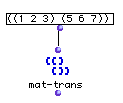OpenMusic Reference
mat-trans

mat-trans
(lists module) -- returns a matrix with the rows and columns exchanged
Syntax
mat-trans matrix
Inputs
| name | data type(s) | comments |
|---|---|---|
| matrix | a tree | with at least one level of nesting |
Output
| output | data type(s) | comments |
|---|---|---|
| first | a tree |
Description
mat-trans transposes a matrix. A matrix is a data structure where data is arranged in multiple dimensions. The simplest kind of matrix is a grid, which can be read as a series of x and y values. A matrix in LISP is a tree with sublists. The tree ((1 2 3) (5 6 7)) is a matrix with two dimensions, i.e. two sublists. mat-trans functions as if the sublists of matrix were arranged vertically, and reads the columns into new lists, which are returned. matrix must therefore be a list of lists.
Examples
Transposing a matrix

The two sublists can be thought of as forming the rows of a matrix:
(1 2 3)
(5 6 7)
of which the columns are read, left to right, into new lists, returning:
? OM->((1 5) (2 6) (3 7))
If matrix were given as ((1 2) (3 4) (5 6) (7 8) (9 10)) then mat-trans returns:
? OM->((1 3 5 7 9) (2 4 6 8 10))
| Prev | Home | Next |
|---|---|---|
| list-modulo | Up | mapcan |